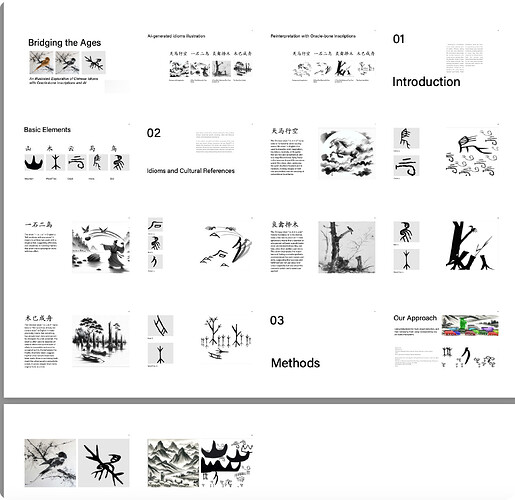 Accepted by CVPR AI Art Gallery 2024.
Accepted by CVPR AI Art Gallery 2024.
It’s my submission to CVPR AI Art Gallery 2024.
Thumbnail:
Intro
“Bridging the Ages: An Illustrated Exploration of Chinese Idioms with Oracle-bone Inscriptions and AI” is a project that intertwines the ancient with the modern by exploring traditional Chinese idioms through the lens of artificial intelligence and oracle-bone inscriptions.
Oracle-bone inscriptions, dating back to the late 2nd millennium BC, represent the oldest attested form of written Chinese. It is logographic, representing elements of the natural world in simplified illustration.
This project introduces four Chinese idioms: “天马行空” (a heavenly steed soaring across the skies), “一石二鸟” (kill two birds with one stone), “良禽择木而栖” (a fine bird selects a fine tree to perch on), and “木已成舟” (the wood has already become a boat), each embodying rich philosophical and historical significance. To reinterpret these idioms, the project employs a combination of AI technologies, including Generative AI for explaining the idioms’ meanings and generating Chinese ink-style illustrations. Furthermore, it utilizes computer vision technology, specifically Detectron2 and approaches from recent research, to detect objects in the images and redraw them using corresponding oracle-bone inscriptions.
The application of these computer vision techniques and AI processes not only brings a fresh perspective to traditional idioms but also showcases the potential of combining historical and artistic elements with modern technology. This project, therefore, stands at the intersection of art, literature, history, and technology, providing a unique lens through which to appreciate the depth and beauty of Chinese cultural heritage while also exploring the capabilities and creative applications of AI.
Similar works by others
【耗时360个小时,用甲骨文制作《千里江山图》 | 小满特别版-哔哩哔哩】
